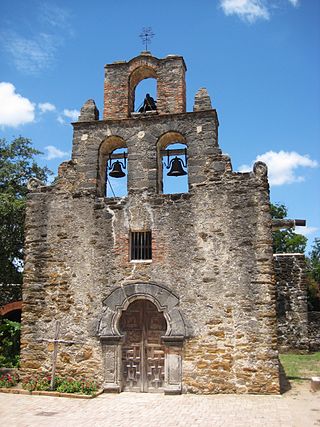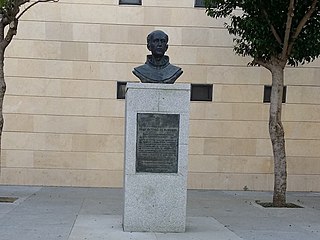Related Research Articles

The Nueces River is a river in the U.S. state of Texas, about 315 miles (507 km) long. It drains a region in central and southern Texas southeastward into the Gulf of Mexico. It is the southernmost major river in Texas northeast of the Rio Grande. Nueces is Spanish for nuts; early settlers named the river after the numerous pecan trees along its banks.
Coahuiltecan was a proposed language family in John Wesley Powell's 1891 classification of Native American languages. Most linguists now reject the view that the Coahuiltecan peoples of southern Texas and adjacent Mexico spoke a single or related languages. Coahuiltecan continues to be a convenient collective term for the languages and people of this region.

Spanish Texas was one of the interior provinces of the colonial Viceroyalty of New Spain from 1690 until 1821. The term "interior provinces" first appeared in 1712, as an expression meaning "far away" provinces. It was only in 1776 that a legal jurisdiction called "Interior Provinces" was created.

The Spanish Missions in Texas comprise a series of religious outposts established by Spanish Catholic Dominicans, Jesuits, and Franciscans to spread the Catholic doctrine among area Native Americans, but with the added benefit of giving Spain a toehold in the frontier land. The missions introduced European livestock, fruits, vegetables, and industry into the Texas area. In addition to the presidio and pueblo (town), the misión was one of the three major agencies employed by the Spanish crown to extend its borders and consolidate its colonial territories. In all, twenty-six missions were maintained for different lengths of time within the future boundaries of the state of Texas.

Mission San Francisco de la Espada is a Roman Rite Catholic mission established in 1690 by Spain and relocated in 1731 to present-day San Antonio, Texas, in what was then known as northern New Spain. The mission was built in order to convert local Native Americans to Christianity and solidify Spanish territorial claims in the New World against encroachment from France. Today, the structure is one of four missions that comprise San Antonio Missions National Historical Park.

Mission San Juan Capistrano was founded in 1731 by Spanish Catholics of the Franciscan Order, on the eastern banks of the San Antonio River in present-day San Antonio, Texas. The new settlement was named for a 15th-century theologian and warrior priest who resided in the Abruzzo region of Italy. The mission San Juan was named after Saint John of Capestrano.
Von Ormy is a city in southwest Bexar County, Texas, United States. As of the 2020 census, it had a population of 1,174. It is part of the San Antonio metropolitan statistical area.

The City of San Antonio is one of the oldest Spanish settlements in Texas and was, for decades, its largest city. Before Spanish colonization, the site was occupied for thousands of years by varying cultures of indigenous peoples. The historic Payaya Indians were likely those who encountered the first Europeans.

Antonio de San Buenaventura y Olivares or simply Fray Antonio de Olivares was a Spanish Franciscan who officiated at the first Catholic Mass celebrated in Texas, and he was known for contributing to the founding of San Antonio and to the prior exploration of the area. He founded, among other missions, the Alamo Mission in San Antonio, the Presidio San Antonio de Bexar, and the Acequia Madre de Valero.
Isidro Félix de Espinosa (1679–1755) was a Franciscan missionary from New Spain who participated in several expeditionary missions throughout the province of Tejas. He was the president of the missionaries from the College of Santa Cruz de Querétaro.

Presidio de Béxar was a Spanish fort built near the San Antonio River, located in what is now San Antonio, Texas, in the United States. It was designed for protection of the mission San Antonio de Valero and the Villa de Béjar. The Presidio de Béxar was founded on May 5, 1718 by Spanish colonial official Martín de Alarcón and his party of thirty-five soldiers. The Villa de Béjar is known for being the first Spanish settlement of San Antonio and consisted of the families of the Presidio Soldiers and those of the prior expeditions. It also served to secure Spain's claim to the region against possible encroachment from other European powers.
The Geier Indians or Geies were an 18th-century group of Indigenous people in what became Mexico and the United States. Little is known about this group.
The Xarames were an Indigenous people of the Americas of the San Antonio, Texas region. They were the dominant Native American group during the early history of Mission San Antonio de Valero. They were a Coahuiltecan people.

The Pajalat were a Native American group who lived in the area just south of San Antonio, Texas, prior to the arrival of the Spanish to the region in the 18th century.

The Coahuiltecan were various small, autonomous bands of Native Americans who inhabited the Rio Grande valley in what is now northeastern Mexico and southern Texas. The various Coahuiltecan groups were hunter-gatherers. First encountered by Europeans in the 16th century, their population declined due to European diseases, slavery, and numerous small-scale wars fought against the Spanish, criollo, Apache, and other Indigenous groups.

The Payaya people were Indigenous people whose territory encompassed the area of present-day San Antonio, Texas. The Payaya were a Coahuiltecan band and are the earliest recorded inhabitants of San Pedro Springs Park, the geographical area that became San Antonio.

Yanaguana was the Payaya people village in the geographical area that became the Bexar County city of San Antonio, in the U.S. state of Texas. Some accounts believe the Payaya also referred to the San Antonio River as Yanaguana, and it is sometimes promoted as such for the tourist industry. For a number of years, the city of San Antonio contracted with Yanaguana Cruises Inc. for an exclusive monopoly to operate tour barges on a select section of the river. The National Park Service has a designated "Yanaguana Trail" that runs along the river at Mission San Juan Capistrano. In 1933 Frederick C. Chabot of San Antonio formed the Yanaguana Society, specifically named for the Payaya village, to collect and preserve the early artifacts and history of the area. The organization lasted through 1960.

Native American tribes in Texas are the Native American tribes who are currently based in Texas and the Indigenous peoples of the Americas who historically lived in Texas.
The Tap Pilam Coahuiltecan Nation is a cultural heritage organization of individuals who identify as lineal descendants of the Coahuiltecan people. They have a nonprofit organization, the American Indians in Texas-Spanish Colonial Missions, based in San Antonio, Texas.
The Sijame were an Indigenous people of the Americas of the San Antonio, Texas region. Some historians believe they were a band of Tonkawa, but they were likely a Coahuiltecan people.
References
- 1 2 3 Jennifer L., Logan. "Reassessing Cultural Extinction: Change and Survival at Mission San Juan Capistrano, Texas". Coahuiltecan Language. NPS.gov. Archived from the original on November 10, 2004. Retrieved September 30, 2020.
- 1 2 3 4 5 6 7 8 9 10 11 12 13 14 15 16 17 18 19 20 Campbell, Thomas N. "Pastia Indians". The Handbook of Texas. Retrieved September 30, 2020.
- 1 2 3 4 5 6 7 "Historic Camps and Crossings on the Medina and San Antonio Rivers". Beyond Texas History.com. Retrieved September 30, 2020.
- 1 2 3 4 5 "Indian Groups at Mission San Jose". San Antonio Mission History. NPSHistory.com. Retrieved September 30, 2020.
- 1 2 3 4 5 6 "South Texas Plains – Who Were the 'Coahuiltecans'?". Texas Beyond History. Retrieved September 30, 2020.